康拉德黑暗的心共42页文档
- 格式:ppt
- 大小:5.45 MB
- 文档页数:42
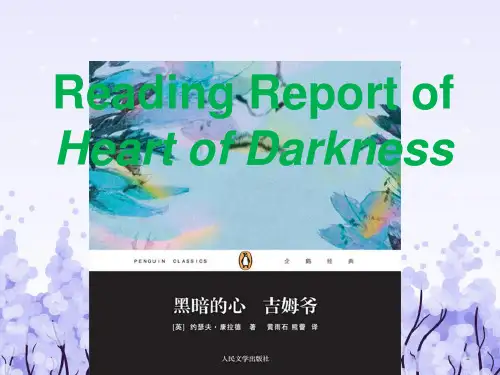
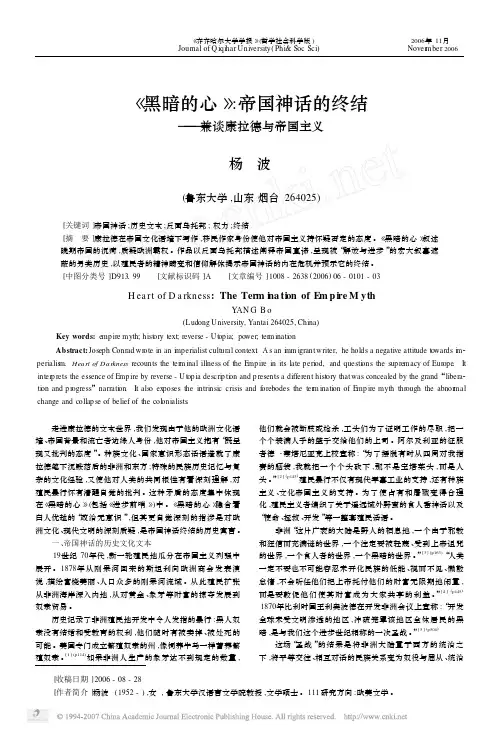
《齐齐哈尔大学学报》(哲学社会科学版)2006年11月Journal of Q iqihar University (Phi&Soc Sci ) Nover mber 2006 [收稿日期]2006-08-28 [作者简介]杨波(1952-),女,鲁东大学汉语言文学院教授,文学硕士。
111研究方向:欧美文学。
《黑暗的心》:帝国神话的终结———兼谈康拉德与帝国主义杨 波(鲁东大学,山东烟台264025)[关键词]帝国神话;历史文本;反面乌托邦;权力;终结[摘 要]康拉德在帝国文化语境下写作,移民作家身份使他对帝国主义持怀疑否定的态度。
《黑暗的心》叙述晚期帝国的沉疴,质疑欧洲霸权。
作品以反面乌托邦描述阐释帝国真谛,呈现被“解放与进步”的宏大叙事遮蔽的另类历史,以殖民者的精神畸变和信仰解体揭示帝国神话的内在危机并预示它的终结。
[中图分类号]D913.99 [文献标识码]A [文章编号]1008-2638(2006)06-0101-03H ea rt of D a rkness :The Term i n a ti on of Em p i re M ythY AN G B o(Ludong University,Yantai 264025,China ) Key words:e mp ire myth;hist ory text;reverse -U t op ia;power;ter m inati on Abstract:Joseph Conrad wr ote in an i m perialist cultural context .A s an i m m igrantwriter,he holds a negative attitude t owards i m 2perialis m.Heart of D arkness recounts the ter m inal illness of the E mp ire in its late peri od,and questi ons the sup re macy of Eur ope .It inter p rets the essence of E mp ire by reverse -U t op ia descri p ti on and p resents a different hist ory thatwas concealed by the grand “libera 2ti on and p r ogress ”narrati on .It als o exposes the intrinsic crisis and f orebodes the ter m inati on of E mp ire myth thr ough the abnor mal change and collap se of belief of the col onialists . 走进康拉德的文本世界,我们发现由于他的欧洲文化语境、帝国背景和流亡者边缘人身份,他对帝国主义抱有“既呈现又批判的态度”。

现代主义形式下的乌托邦幻想——对康拉德小说《黑暗的心》
的研究
何信玉
【期刊名称】《英美文学研究论丛》
【年(卷),期】2015(000)001
【摘要】《黑暗的心》(1899)是英国现代主义作家约瑟夫·康拉德的重要作品,小说
形式上的现代主义尝试及其蕴含的现代主义世界观历来是文学批评争论的焦点.本
文试图在马克思主义文艺理论的指导下,探讨小说中蕴含的现代主义与悲剧内涵.通
过结合康拉德本人的阶级立场与生活经历,发掘小说在形式改造中体现的意识形态
意义,进而看到资本主义意识形态危机如何在小说中以“一种乌托邦式的梦幻”展
现出来.然而,在欲望膨胀的资本主义社会中,“形式的政治”、“主体性的真实”、“无力的乌托邦冲动”等等,更多呈现出来的是一种对未来的不确定性,建构的是一
个朦胧的微观世界,康拉德的现代主义世界观并没有办法化作现实的行动力去改造
世界.
【总页数】14页(P126-139)
【作者】何信玉
【作者单位】上海交通大学
【正文语种】中文
【相关文献】
1.康拉德《黑暗的心》中的现代主义元素 [J], 李彬
2.康拉德小说的殖民主义批判意识——以《黑暗的心》及其它两篇小说为例 [J], 王宏;熊洁
3.约瑟夫·康拉德小说的创伤叙事与幽暗意识——以《黑暗的心》和《进步前哨》为例 [J], 张茂君
4.约瑟夫·康拉德小说的创伤叙事与幽暗意识--以《黑暗的心》和《进步前哨》为例[J], 张茂君
5.康拉德小说中的道德反思——从后殖民主义视角解读康拉德的《黑暗的心》 [J], 马越
因版权原因,仅展示原文概要,查看原文内容请购买。

文学对抗社会压迫- 殖民主义的反思与约瑟夫·康拉德的《黑暗之心》1. 引言1.1 概述在社会的发展进程中,殖民主义和社会压迫一直是重要的议题。
殖民主义作为一种政治、经济和文化霸权的形式,对被殖民地区造成了深远的影响,并进一步导致了社会压迫的出现。
然而,文学作为一种艺术表达形式,在对抗社会压迫中发挥了积极的作用。
本篇长文将以约瑟夫·康拉德的小说《黑暗之心》为例,探讨文学如何反思殖民主义并对抗社会压迫。
1.2 文章结构本文分为五个部分:引言、殖民主义与社会压迫、文学作为反思工具、约瑟夫·康拉德与《黑暗之心》简介以及结论。
首先,引言部分将提供文章背景和目的,并概述主要内容。
其次,在对殖民主义和社会压迫进行定义和探讨后,我们将着重介绍文学在反思这些问题上起到的重要作用。
随后,通过介绍约瑟夫·康拉德及其时代背景以及《黑暗之心》的主题和故事梗概,我们将详细分析该小说中对抗社会压迫的手法和意义。
最后,结论部分将总结文学对抗社会压迫的重要性与价值观点,并强调《黑暗之心》在文学反思中的地位和影响力。
1.3 目的本篇长文旨在探讨文学如何通过反思殖民主义来对抗社会压迫。
我们将以约瑟夫·康拉德的小说《黑暗之心》为例,深入剖析其揭示的社会问题并分析其中表达反对社会压迫的手法。
通过解读康拉德作品中所蕴含的批判精神,我们将展示文学在启发人们思考、改变观念以及推动社会进步方面无可替代的力量。
同时,本文也将呼吁更多研究者关注文学作品中反抗社会压迫主题,并提出未来研究方向与展望。
2. 殖民主义与社会压迫2.1 定义和背景殖民主义是指一个国家将自己的政治、经济和文化体系强加到另一个地区或国家,并通过控制和剥削其资源和人民来获得利益的行为。
这种行为往往伴随着不公平的权力关系,导致被殖民地受到了极大的社会压迫。
历史上,欧洲国家对亚洲、非洲和美洲进行了大规模的殖民扩张。
他们通过武力征服和控制其他地区,建立了自己的殖民地帝国。
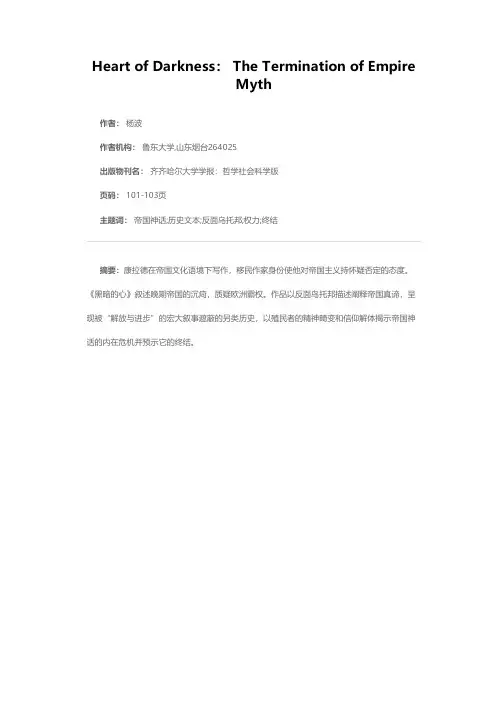
Heart of Darkness: The Termination of Empire
Myth
作者: 杨波
作者机构: 鲁东大学,山东烟台264025
出版物刊名: 齐齐哈尔大学学报:哲学社会科学版
页码: 101-103页
主题词: 帝国神话;历史文本;反面乌托邦;权力;终结
摘要:康拉德在帝国文化语境下写作,移民作家身份使他对帝国主义持怀疑否定的态度。
《黑暗的心》叙述晚期帝国的沉疴,质疑欧洲霸权。
作品以反面鸟托邦描述阐释帝国真谛,呈现被“解放与进步”的宏大叙事遮蔽的另类历史,以殖民者的精神畸变和信仰解体揭示帝国神话的内在危机并预示它的终结。
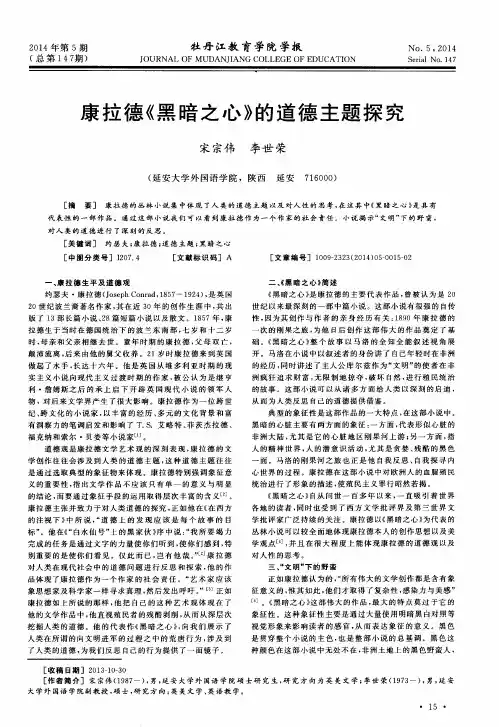
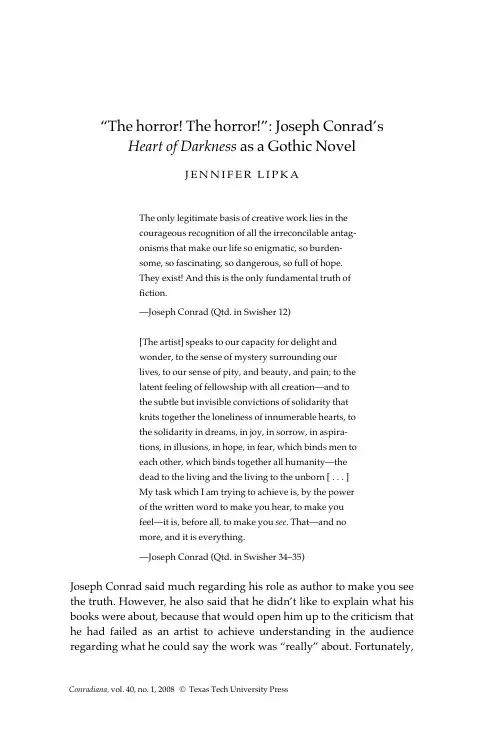
“The horror! The horror!”: Joseph Conrad’s Heart of Darkness as a Gothic NovelJ E N N I F E R L I P K AThe only legitimate basis of creative work lies in thecourageous recognition of all the irreconcilable antag-onisms that make our life so enigmatic, so burden-some, so fascinating, so dangerous, so full of hope.They exist! And this is the only fundamental truth offiction.—Joseph Conrad (Qtd. in Swisher 12)[The artist] speaks to our capacity for delight andwonder, to the sense of mystery surrounding ourlives, to our sense of pity, and beauty, and pain; to thelatent feeling of fellowship with all creation—and tothe subtle but invisible convictions of solidarity thatknits together the loneliness of innumerable hearts, tothe solidarity in dreams, in joy, in sorrow, in aspira-tions, in illusions, in hope, in fear, which binds men toeach other, which binds together all humanity—thedead to the living and the living to the unborn [... ]My task which I am trying to achieve is, by the powerof the written word to make you hear, to make youfeel—it is, before all, to make you see. That—and nomore, and it is everything.—Joseph Conrad (Qtd. in Swisher 34–35)Joseph Conrad said much regarding his role as author to make you see the truth. However, he also said that he didn’t like to explain what his books were about, because that would open him up to the criticism that he had failed as an artist to achieve understanding in the audience regarding what he could say the work was “really” about. Fortunately, Conradiana,vol. 40, no. 1, 2008 © Texas Tech University Pressthe field of literary criticism, theory, and interpretation have stepped in to (ad)venture failure in explaining the meaning and significance of Heart of Darkness . This is another such (ad)venture into the teeming jungle of Conrad’s long short story (or short novel), and the equally wild overgrowth of vegetation that is Conrad studies, criticisms, com-mentaries, and interpretations. According to the editor of the most recent Heart of Darkness casebook, “[t]he cutting edge of literary criti-cism seems to swing between formal and cultural- h istorical approaches every twenty years or so” with a pendulum whose swath swings (cuts)through postcolonialism, the adventure genre, historicism, irony,metaphor, the imagery of language, modernism, postmodernism, femi-nism, deconstructionism, psychology and psychoanalysis, authorial intention, and the philosophical branches of epistemology, morality,and metaphysics (Moore 7). Certainly no Castle of Otranto . Ironically,that is exactly what the lack and void is regarding this novel, where “the meaning of an episode was not inside like a kernel but outside,enveloping the tale which brought it out only as a glow brings out a haze, in the likeness of one of these misty halos that sometimes are made visible by the spectral illumination of moonshine” (Heart 68). Not enough attention has been given to Heart of Darkness as a serious novel of horror, a prime example of the highest of British Gothic fiction. This hero’s quest, then, is to examine the flaws and benefits of the more famous works regarding Heart of Darkness and then discuss the work as a Gothic novel, all in terms of the question, Can “traditional” examina-tions of Heart of Darkness do the story the justice that an interpretation of the novel focusing on its Gothic elements can?Woe to Walter F. Wright, who in his 1949 essay “Ingress to the Heart of Darkness ” wrote “[w]e perceive that Africa itself, with its forests, its heat, and its mysteries, is only a symbol of the larger darkness, which is in the heart of man.” (Qtd. in Harkness, Conrad’s 155) In 1975, all discus-sion of the Western literary canon, Joseph Conrad, and Heart of Darkness “burst into a blaze so suddenly that you would have thought the earth had opened to let an avenging fire consume all that trash” (Heart 90).Nigerian author Chinua Achebe, a nonfictional African raised in a non-fictional African society shaped by European colonialism, denounced Conrad as a “bloody racist” with “a problem with niggers”; Heart of Darkness as a portrayal of Africans as dumb brute (animal) rudimentary soul savages in a frenzy; and the Western world as a bunch of paternal-ists who think they can somehow comprehend what racism and colo-nialism has wrought on Africans (Achebe 190). This taught the white C O N R A D I A N A 26L I P K A—”The horror! The horror!”27 man the meaning of frenzy—not surprisingly, many critics and inter-preters of Conrad are male, white, Western, and European, and the still existent frantic and heated attempts to rescue or damn Heart of Darkness have filled more pages than the novel itself. The reaction to Achebe is almost a story unto itself, a study in the guilt of the white man, the ques-tioning and evaluating of the values of Western culture, and the birth and popularity of colonial studies and the desire to hear from non-E uropeans regarding how the brute force and greed of the Western world have forever altered their cultures.Out of fear that the political, historical, and colonial readings of the novel have done a disservice to the true message of Heart of Darkness,a hard push has been given to embrace the universality of the story as a message of how to live with the knowledge of the evil that exists in every heart, male or female, black or white (Harkness, “Old- F ashioned”41). One piece of evidence for the universality of the theme is Francis Ford Coppola’s film Apocalypse Now,which moves Heart of Darkness to Vietnam, with Kurtz a renegade American military star who must be exterminated with extreme prejudice for his unsound methods during the Vietnam War (Cahir 183–85). The argument can, however, easily be made that Apocalypse Now portrays Southeast Asians by using racial stereotypes. Rather than saying the issue of race should be ignored entirely, so as to examine Heart of Darkness as Gothic genre piece, it is perhaps more constructive to show how the issue of race opens up one area of psychological interpretations of the novel, that being how we relate to the Other.The difference between I and Other has been much explored as the source of both racism and sexism (Odajnyk 88). Psychoanalyst and cul-tural theorist Julia Kristeva said that facing the abject, which she calls the most violent form of psychological horror, is seeing the I and the Other (250). The I and Other are mentioned now as an introduction to philosophical implications of the novel in terms of self, the formation of identity, and the formation/learning of morality—as this does con-tribute to why we experience the psychological horror that we do.If the Other is a source of horror, in that it is different from the self (or I), what is the self? “All Europe contributed to the making of Kurtz”(Heart123). According to the French philosopher Louis Althusser, this is indeed true. As a Marxist and a determinist who denied individual freedom, Althusser coined the notion of Ideological State Apparatuses (ISA), everything from churches to schools to the family to the govern-ment, as the institutions which shape the self (132, 154–56). Marlowacknowledges how another social institution, that of language, is also nothing more than a tool used to justify one’s identity. When Marlow realizes that the ornamentation of the fence by Kurtz’s hut is actually rotting heads on stakes, the Russian tries to lessen his horror at this bar-barity by explaining that “these are the heads of rebels. I shocked him excessively by laughing. Rebels! What would be the next definition I was to hear? There had been enemies, criminals, workers—and these were rebels. Those rebellious heads looked very subdued to me on their sticks” (Heart 134). If the self is a void in the absence of social construc-tions, the absence of ISAs helps explain Kurtz’s uncivil behavior in “utter solitude without a policeman [... ] where no warning voice of a kind neighbour can be heard whispering of public opinion” (Heart 122).German philosopher Arthur Schopenhauer agreed that an absence of social institutions implies an absence of morality: “Might it not follow from a retrospective glance at the vain attempts to find a sure basis of morals from more than 2,000 years that there is no natural morality at all that is independent of human institutions? [Morality is] an artificial product, a means invented for the better restraint of the selfish and wicked human race.” (qtd. in Madden 43) However, Schopenhauer did not believe that the human is without a self in the absence of ISAs. As a pessimist, he believed in the human being as little more than an evil ego, and life as a lie regarding our true nature:If every individual were given the choice between his own destruction and that of the rest of the world, I need not say how the decision would go in the vast majority of the cases [... ] At such moments when we do have an opportunity to see the boundless egoism of almost everyone,the wickedness of many, and the cruelty of not a few [... ] we [... ]imagine we have chanced upon a monster never before seen.” (Madden 45–47)Marlow expresses the boundless egos of the pilgrims and of Kurtz, and also the role of appearances and illusions used by “civilization” to avoid facing the truths about itself. Marlow sees that he has entered a Nietzschean world beyond good and evil, and from this perspective is troubled by all the contradictions inherent within the “civilized world,”such as the noble intentions of Kurtz, representative of the International Society for the Suppression of Savage Customs, creating the Kurtz who “presides at certain midnight dances ending with unspeakable rites,which—as far as I reluctantly gathered from what I heard at various C O N R A D I A N A 28L I P K A—”The horror! The horror!”29 times—were offered up to him—do you understand? To Mr. Kurtz himself” (Heart123). It is these contradictions that lead Marlow into taking a journey into his unconscious mind, and it is this journey into darkness that is best expressed through viewing Heart of Darkness as a Gothic novel.While it is the feeling of dread conveyed which is the hallmark of all Gothic literature and this alone can qualify Conrad’s novel as Gothic, Heart of Darkness belongs to the nineteenth- c entury psychological G othic—although it does contain many classic Castle of Otranto early G othic elements, such as a far- o ff, exotic setting, “nightmares,”“visions,” night and darkness aplenty, a damned soul, and a “ghost”haunting Marlow:I had a vision of him on the stretcher, opening his mouth voraciously, asif to devour all the earth with all its mankind. He lived then before me;he lived as much as he had ever lived—a shadow insatiable of splendid appearances, of frightful realities; a shadow darker than the shadow of the night, and draped nobly in the folds of a gorgeous eloquence. [... ] And the memory of what I had heard him say afar there, with the horned shapes stirring at my back, in the glow of fires, within the patient woods, those broken phrases came back to me, were heard again in their ominous and terrifying simplicity. [... ] I rang the bell before a mahogany door on the first floor, and while I waited he seemed to stare at me out of the glassy panel—stare with that wide and immense stare embracing, condemning, loathing all the universe. I seemed to hear the whispered cry, ‘The horror! The horror!’” (Heart152–53).Conrad scholar Frederick R. Karl called Heart of Darkness the Danse Macabre and called the work a new version of Coleridge’s Ancient Mariner, as Marlowhas suffered through a nightmare, an experience that sends him back a different man, now aware of depths in himself that he cannot hide. The tale he narrates on the Nellie is one he is unable to suppress; a modern version of Coleridge’s Ancient Mariner, he has discovered a new world and must relate his story to regain stability. (144)In addition to Kurtz’s ghost, C. B. Cox noted that the first circle of Dante’s Hell, the office in Belgium (leading to the boat, to the Company Station, the Central Station, and finally the Inner Station), is guarded bytwo women knitting black wool (the Fates?), one of whom is depicted as a witch—complete with cat on her lap, an evil eye, and a wart on her nose (47).The thematic notion of the nightmare and the dream are standard themes of the Gothic (Sedgwick 4). While Marlow repeatedly says he is living the nightmare of his choice, living a waking horrific dream,Conrad structurally wrote the story in language that is very dreamlike.Ian Watt has called this Conrad’s impressionism, the art of “delayed decoding,” in which events are described before the reader knows what has happened (11). While Conrad’s artistic use of language has made him of interest to modernist, postmodernist, and deconstructionist cir-cles, this is an excellent literary technique for a Gothic novel, as the ini-tial descriptions make the reader uneasy with the unknown, which is slowly drawing them in to a shock:My purpose was to stroll into the shade for a moment; but no sooner within that it seemed to me I had stepped into the gloomy circle of some Inferno. [... ] Black shapes crouched, lay, sat between the trees leaning against the trunks, clinging to the earth, half coming out, half effaced within the dim light, in all the attitudes of pain, abandonment, and despair. [... ] These moribund shapes were free as air—and nearly as thin. I began to distinguish the gleam of the eyes under the trees. Then,glancing down, I saw a face near my hand. (Heart 81–82)In terms of psychoanalysis, language and irony act like a veil between a patient and the horror of a traumatic experience (Murfin 15).However, Conrad used language and irony with great skill to create a real feeling of uneasiness—the absurd is not just funny, but the absurd among such horror puts the so- c alled rational world in question. Karl Marx said that “The claim that the rational is actual is contradicted pre-cisely by an irrational actuality, which is everywhere the contrary of what it asserts and asserts the contrary of what is.” (qtd. in Ravel 9)Conrad artistically uses such contradictions between the rational and irrational to create a very interesting psychological effect in the reader:One evening a grass shed full of calico, cotton prints, beads, and I don’t know what else, burst into a blaze so suddenly that you would have thought the earth had opened to let an avenging fire consume all that trash. I was smoking my pipe quietly by my dismantled steamer, and saw them all cutting capers in the light, with their arms lifted high,C O N R A D I A N A 30L I P K A—”The horror! The horror!”31when the stout man with moustaches came tearing down to the river, a tin pail in his hand, assured me that everybody was “behaving splen-didly, splendidly,” dipped about a quart of water and tore back again. I noticed there was a hole in the bottom of his pail. (Heart90)Absurd moments like this are exactly what keep Marlow in a dreamlike “sense- l ess delusion” beyond that “that had its reason, that had meaning” (Heart78). Marlow has brief moments where he has a grip on reality: “For a time I would feel I belonged still to a world of straightfor-ward facts; but the feeling would not last long” (Heart78).Another structural convention of the Gothic evident in Heart of Dark-ness is the likelihood “to be discontinuous and involuted, perhaps incorporating tales within tales, changes of narrator” (Sedgwick 9). The novel also uses what has been called “Gothic therapeutic dialogue”: just as the Ancient Mariner tells his tale to the Wedding Guest, Frankenstein his tale to Robert Walton, and Nelly Dean the tale of Wuthering Heights to Mr. Lockwood, Marlow tells his tale to his shipmates aboard the Nellie(Brennan 11). And whether in terms of a session on the couch or on the other side of the veil from a priest, Conrad did consider the novel to be his “confessional” (Gose 131).Real horrors do fill the pages of Heart of Darkness,be they heads on stakes or the grove of death. Yet the message of the work is that the real horror has been internalized and lies within the heart, the heart of dark-ness. Marlow himself makes a distinction between the outside threat of danger and terror to the most extreme terror, which is a product of the mind:The fact is I was completely unnerved by a sheer blank fright, pure abstract terror, unconnected with any distinct shape of physical danger.What made this emotion so overpowering was—how shall I define it?—the moral shock I received, as if something altogether monstrous, intol-erable to thought and odious to the soul, had been thrust upon me unex-pectedly. This lasted of course the merest fraction of a second, and then the usual sense of commonplace, deadly danger, the possibility of a sudden onslaught and massacre, or something of the kind, which I saw impending, was positively welcome and composing. (Heart141)The birth of Gothic as a literary genre was a reaction to the Enlighten-ment era’s extreme leanings towards the rational; the Gothic goal was to exalt the senses over reason by taking the reader into “the abyss thatincapacitates our power of cognition” (Brennan 3). During the nine-teenth century, the outer ghouls of Gothic became the inner ghouls of G othic, the “demon” became the “daimon” (G ose 169). According to Matthew C. Brennan, the Gothic psyche is the most perfect literary rep-resentative of Jungian psychology, an example of what Jung called “visionary art,” which reaches into the dark recesses of the human mind to express the collective unconscious (13). The monsters and sav-iors of Gothic literature are Jung’s doubles and archetypes, and Kurtz is not just Marlow’s double, but his “shadow” (Brennan 15). The lead in a Gothic novel is acting out his own therapy, which is to serve as lesson to the reader:Gothic works all depict the failure of individuation in at least one key character; in different ways, they depict the collapse of the psyche and disintegration of the Self [... ] Sometimes, though, the G othic also includes characters who manage to integrate the experience of a destructive cautionary tale and thus to strengthen themselves psycho-logically. (Brennan 10)According to Brennan, Jung would consider the ending of Heart of Dark-ness,the lie to the Intended, a happy ending. Marlow does not become Kurtz; he realizes that the truth is “too dark—too dark altogether,” and despite his own anger at the lie which is the illusion the Intended must hold as her memory of Kurtz, he acts like a good civilized man who must act as if goodness and faith prevail (Heart 157). Marlow has confronted how destructive his choice of nightmare has been, and consciously chooses to reintegrate himself into “healthy” society (Brennan 25).Can it really be said that Heart of Darkness has a happy ending or therapeutic value, for either Marlow or the reader? If it is a G othic novel, what has happened to the feeling of dread? Does it not linger long after the novel is finished? Isn’t Conrad pointing out that the “healthy” society in the novel is not at all healthy? Does Marlow awake from his nightmare? H. P. Lovecraft considered Joseph Conrad a fine example of “The Weird Tradition in the British Isles” in his 1927 treatise on horror in literature, which does not use the language of G othic critics, but still contains interesting reflections regarding the psy-chology of fear.The oldest and strongest emotion of mankind is fear, and the oldest and strongest kind of fear is fear of the unknown. These facts few psycholo-C O N R A D I A N A 32L I P K A—”The horror! The horror!”33gists will dispute, and their admitted truth must establish for all time the genuineness and dignity of the weirdly horrible tale as a literary form [... ] As may naturally be expected of a form so closely connected with primal emotion, the horror- t ale is as old as human thought and speech themselves. Cosmic terror appears as an ingredient of the ear-liest folklore of all races. (Lovecraft 12, 17)This statement on the universality of fear helped Lovecraft to argue that the horror tale will always persist in literature, despite the fact that the unknown world is shrinking due to advancements in science. While he argued that there is a physiological fixation on what is mysterious, he also said that only a small minority of the population can truly appre-ciate the weird, the horrific, and that which inspires dread—because only a minority of the population appreciates and uses the imagination (Lovecraft 13).Lovecraft’s use of “minority” and “imagination” are what makes certain elements of Freudian psychology particularly interesting tools in opening up a discussion about “the truth” of Heart of Darkness,which, fortunately, has little to do with “the snake- l ike river is the penis pene-trating the female body of the wilderness” (15). Freud himself devel-oped the theory of the “unheimlich”—the eerie and uncanny, which is “that class of the frightening, which leads back to what is known of old and long familiar” (Freud 123–24). Marlow begins his tale by letting his listeners know that the familiar Thames “also [... ] has been one of the dark places of the earth,” and tells his tale in miniature fashion as the conquest of England by the ancient Romans (Heart67). By the end of Marlow’s tale, the familiar has become the unfamiliar, the uncanny, as evidenced by the last words of the novel, spoken by the narrator. Entranced by Marlow’s tale, he now recalls himself on deck the Nellie, remembers his task to set sail, and looks out at the familiar Thames:“[t]he offing was barred by a black bank of clouds, and the tranquil waterway leading to the uttermost ends of the earth flowed sombre under an overcast sky—seemed to lead into the heart of an immense darkness” (Heart158). Freudian Julia Kristeva wrote about the abject being more violent than the uncanny, because the abject contains nothing familiar. Kristeva said that the abject resembles the sublime with its ability to carry one away, making one lose control (or, as Marlow or Conrad might say, restraint) over one’s self. However, the real horror of the abject is that it makes known that there is a certain truth, a certain reality, that if acknowledged by a person will annihilatethem (Kristeva 250). Freudian Jacques Lacan, whose mirror stage of development theory depends on what humans see, also said that behind reality is the real, which only a few see, and not to their psycho-logical benefit (Devlin 716). R. A. Gekowski argued that “Kurtz sees too much, too clearly, to live through the experience,” lending credence to the idea that there is a minority which does see that certain reality, that real behind reality, which annihilates them (86).This notion of what Marlow and Kurtz “see” leads the discussion to the image, and then to the imagination: “[t]he image is the starting point and in some measure the immediate matter of all our intellectual opera-tions. It is certain that any cessation of imaginative activity puts an end at once to intellectual function” (de Munnynck, under “Elaboration of Images by the Intellect”). That Marlow tells his tale to the crew of the Nellie sitting like “a Buddha preaching” is an image that plays not just on the transcendent enlightenment Marlow experienced on his trip to rescue Kurtz, but also on Eastern beliefs that all is one, the two parts come together as one—here not just in terms of the natures of the dou-bles or shadows Kurtz and Marlow, but also in terms of the irrational and the rational, the known and the unknown (Heart 69). Why does Lovecraft insist only a minority in the population can truly appreciate tales of the weird, and why do only a few, like Kurtz and Marlow, see the real that lies behind the reality—“The horror! The horror!”?According to Gekowski, “[t]he Manager of the Central Station and the other ‘fools’ of the story can never descend to the ‘heart of darkness’because they have no ‘imagination’” (83). Conrad himself said that there are only two options of living in this world—the one option is as an idiot who does not see or think, the other as a convict who sees and thinks (Watt 8).What does this mean for the interpretation that the heart of darkness is in every man? Despite the fact that every human being, for their own self- e steem (if not for their ignorance), must think of themselves as good, the potential for great evil lies in the heart of Everyman, with the only question being, what will bring the darkness to light? Do humans possess the imagination, the ability to see, to understand this potential for evil? When Marlow enters the grove of death, he is horrified:“Marlow’s shock, his amazement before the sheer strangeness of the ravaged human forms anticipates what the Allied liberators of the con-centration camps felt in 1945” (Denby 252). Before his journey, Marlow could not imagine the horrors he witnessed and lived.Heart of Darkness is not important as a historical document of what C O N R A D I A N A 34L I P K A—”The horror! The horror!”35 was, or a piece of colonial literature to understand why politics and cul-ture are like they are now in real regions of the world. Heart of Darkness is important as a Gothic novel, inspiring readers with the horror, the dread, of what is. Heart of Darkness states humanity should not have to live and witness such horrors as Marlow to understand that the human heart contains an evil that does exist. When Hannah Arendt attended the trial of Nazi war criminal Adolf Eichmann in Jerusalem in 1961, she was shocked at what a normal human being Eichmann was, even noting that while on trial he said “that he had lived his whole life . . . according to a Kantian definition of duty [... ] to the surprise of every-body, Eichmann came up with an approximately correct definition of [Kant’s] categorical imperative” (Kohn 7). The Holocaust started Arendt on a decades- l ong search to understand the nature of evil, due to the twentieth century’s “unprecedented, [... ] incredible, [... ] monstrous” events which seemed to defy man’s understanding (Yar, under “7. Thinking and Judging”). Could passivity, the latent desires of the masses, a lust for power, the “lying world order,” or man’s inhu-manity be at fault? (Kohn 5). Eichmann was not the incarnation of evil, Arendt decided, nor were the passive masses that allowed such horrors to be perpetrated. Arendt changed her philosophy of “radical evil” to the “banality of evil”—Eichmann and most people are simply thought-less and lack both the ability to think critically about their actions and the imagination needed to comprehend the consequences of their actions (Yar, under “6. Eichmann and the ‘Banality of Evil’”). The offi-cial 9/11 National Commission Report also stated that one reason the attacks of 9/11 were not prevented is that the Intelligence community lacked the “imagination” necessary to envision, and therefore prevent, the attacks (under “G eneral Findings”). Thoughtlessness makes evil concrete, and the only method to prevent evil is to actively exercise the imagination: This new “‘broadened way of thinking’”—“‘thinking without a banister’”—with an “‘enlarged mentality’” allows us to “‘put ourselves in the position of everybody else’” (Yar, under “7. Thinking and Judging”). Imagination allows not just for this sort of empathy, feeling what actually is for other people, but allows for the perception of what could be,as literally anything is possible. Marlow himself says this within what is not only a beautiful description of the “unheimlich” in action but also a moment where the Other becomes the I, and the I the Other. Marlow stands on the steamer, which glides down the river, past throngs of “of a black and incomprehensible frenzy,” disturbing for “their humanity—like yours”:。

作者: 郑蓉颖
作者机构: 华北电力大学外语学院北京102206
出版物刊名: 名作欣赏
页码: 123-127页
主题词: 自然;道德;文明;堕落
摘要:约瑟夫·康拉德是英国现代小说史上的一位重要作家,在他三十年的创作生涯中,共出版了三十一部作品,他的作品大多是和大自然有着紧密的关系,大自然也是他的作品的背景和源泉.生活就是和自然的斗争.人类的道德也是在对自然界的不断认识中形成的.分析其代表作《黑暗的心》中的主题,"黑暗"之所以能够"征服"于人,是因为道德的堕落.主人公马洛对库尔兹的寻觅过程也是对其心灵堕落的历程的解构,是对欧洲文明的道德从崇高到毁灭的揭示.道德的批评是康拉德写作的最初意图.。
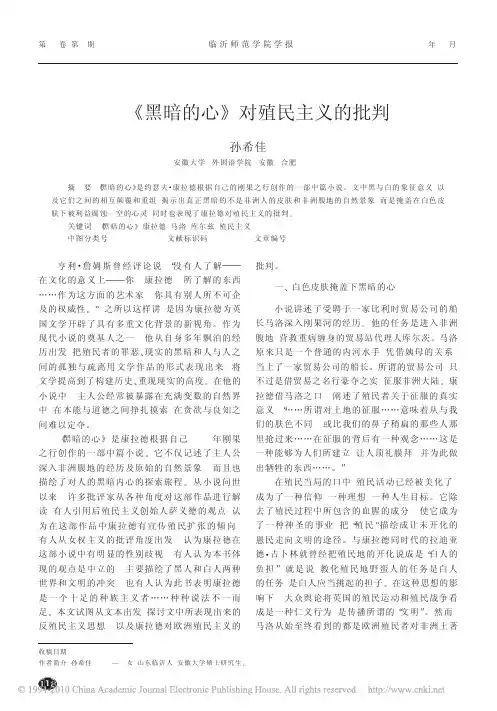
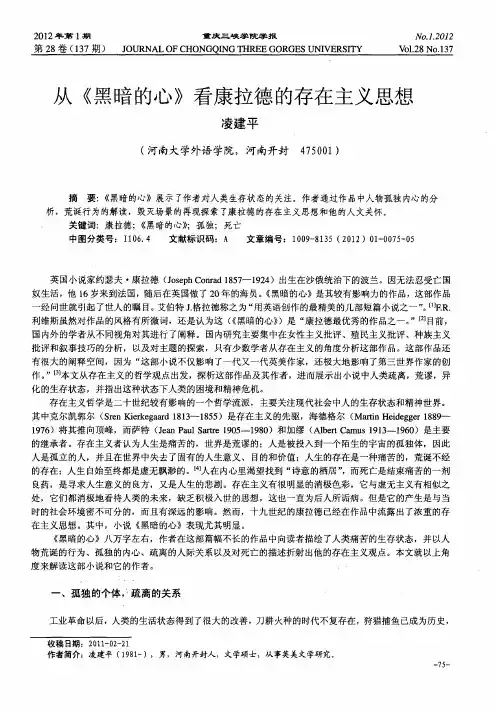
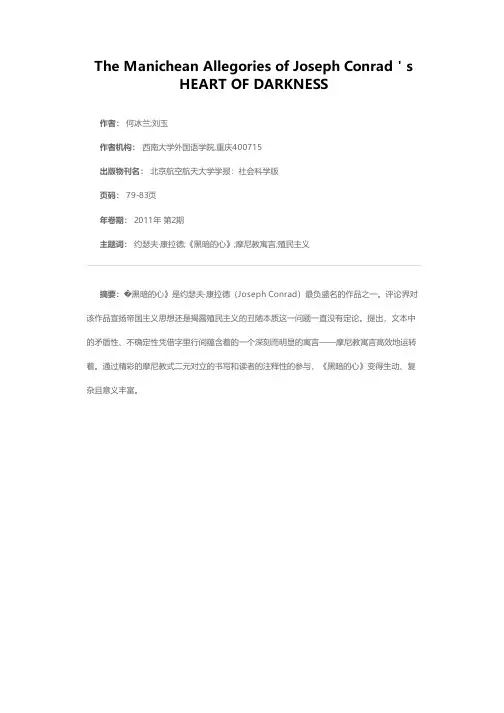
The Manichean Allegories of Joseph Conrad's
HEART OF DARKNESS
作者: 何冰兰;刘玉
作者机构: 西南大学外国语学院,重庆400715
出版物刊名: 北京航空航天大学学报:社会科学版
页码: 79-83页
年卷期: 2011年 第2期
主题词: 约瑟夫·康拉德;《黑暗的心》;摩尼教寓言;殖民主义
摘要:�黑暗的心》是约瑟夫·康拉德(Joseph Conrad)最负盛名的作品之一。
评论界对该作品宣扬帝国主义思想还是揭露殖民主义的丑陋本质这一问题一直没有定论。
提出,文本中的矛盾性、不确定性凭借字里行间蕴含着的一个深刻而明显的寓言——摩尼教寓言高效地运转着。
通过精彩的摩尼教式二元对立的书写和读者的注释性的参与,《黑暗的心》变得生动、复杂且意义丰富。
黑暗的心读后感《黑暗的心》是英国作家约瑟夫·康拉德创作的一部小说,拥有深刻的思想内涵和独特的艺术风格。
该小说探索了人性的黑暗面,揭示人类内心深处的恶与腐败。
读完这本小说,我对人性的复杂性有了更深层次的认识。
小说以一个传教士的故事展开,讲述了主人公马洛与他的追求光明善良的使命。
然而,当他来到了非洲的黑暗深处,他逐渐意识到,人性并不总是光明正大的,相反,恶与腐败隐藏在每个人的内心。
小说以马洛的视角展现了一个虚构的非洲国家。
描述了当地的残忍暴力,蛮荒的环境以及原始的人民生活状态。
同时,小说也着重描写了白人殖民者的腐败和不道德行为,他们为了自己的私利而不择手段地榨取当地人的劳动力和财富。
小说中,康拉德通过生动的语言和精彩的描写,将黑暗深处的非洲与主人公内心的黑暗联系在一起。
他用象征和隐喻手法表达了人性的复杂性和黑暗的一面。
例如,象征性的人物库尔茨,他追求无尽的权力和财富,最终被黑暗吞噬,失去了自我。
而马洛通过接近库尔茨,与其共同经历了黑暗的旅程,使得他对人性的认知更加完整和深刻。
通过《黑暗的心》,康拉德探索了人性的两面性。
他认为,每个人心中都有一片黑暗,只是程度不同。
人性的本质并不纯善,而是包含了欲望、权力和动机等不同的因素。
在黑暗的环境下,这些黑暗的一面会更加显现,使得人们做出残忍和邪恶的行为。
康拉德认为,只有通过意志力和良知的约束,才能控制和抵御这种黑暗的引诱。
正因为康拉德对人性的深刻洞察和思考,让《黑暗的心》成为了一部具有思想性和哲学性的小说。
通过对真实世界与内在世界的对比,作者向读者传达了一个重要的信息,那就是人性的复杂性与困境。
只有正视人性的黑暗面,才能够更好地认识自我,并努力追求光明和善良。
读完《黑暗的心》,我对人性的理解更加深入和全面。
人们的内心是十分复杂和迷离的,我们都会面临诱惑和抉择的时刻。
只有通过真实地认识自我,坚守良知和道德底线,才能够抵御黑暗的诱惑,走向光明的未来。
总之,康拉德的《黑暗的心》是一部充满思想深度和压抑气氛的小说。
黑暗的心第一章到第二章主要内容的总结摘要:1.《黑暗的心》第一章到第二章的背景和主题2.主人公尼克尔斯的介绍3.第一章的主要情节和主题4.第二章的主要情节和主题5.第一章到第二章的过渡和悬念正文:《黑暗的心》是英国作家约瑟夫·康拉德的一部经典小说,全书共分为两章。
这两章主要围绕着主人公尼克尔斯的视角展开,描绘了他在非洲刚果河流域的经历。
1.《黑暗的心》第一章到第二章的背景和主题这两章的背景设定在19 世纪末的非洲刚果河流域,当时这个地方正处于比利时国王利奥波德二世的殖民统治之下。
这部小说的主题是人性、道德和文明的冲突,通过主人公尼克尔斯的经历,探讨了欧洲人在非洲的殖民行为对当地人以及欧洲人自身的影响。
2.主人公尼克尔斯的介绍尼克尔斯是一名英国船长,受雇于一家英国贸易公司。
他是一个矛盾重重的人物,一方面他对非洲土著抱有同情心,另一方面他又无法摆脱欧洲殖民者的优越感和对财富的渴望。
3.第一章的主要情节和主题第一章主要讲述了尼克尔斯在非洲刚果河流域的航行经历。
他在这里遇到了一个名叫库尔茨的德国人,库尔茨是一个狂热的探险家,他为了寻找财富,深入非洲内地,对当地的土著进行了残酷的剥削和压迫。
在这一章中,尼克尔斯目睹了库尔茨的暴行,开始对欧洲人的殖民行为产生了质疑。
4.第二章的主要情节和主题第二章主要讲述了尼克尔斯在非洲的经历。
他在这里遇到了一个名叫马洛的比利时人,马洛是一个道德沦丧的殖民者,他为了追求财富,不择手段地压迫和剥削非洲土著。
在这一章中,尼克尔斯对马洛的行为感到震惊,开始反思自己的行为和价值观。
5.第一章到第二章的过渡和悬念在第一章和第二章之间,尼克尔斯从库尔茨的暴行中看到了欧洲殖民者的丑陋面目,然后在第二章中又目睹了马洛的罪行。
这两章之间的过渡通过尼克尔斯的心理变化来实现,他的道德观念和价值观逐渐发生了改变。
《黑暗的心》,黑人的自我构建引言《黑暗的心》是康拉德重要代表作品之一。
在整部小说中,康拉德构建的精神王国是基于欧洲人崇高的白色神话之下的奴役与征服黑非洲的欲望投射。
在此过程中,不难发现整部小说透出较为浓厚的后殖民主义色彩。
随着切入点的多元化,结合当下比较文学形象学的相关研究领域,我们也能够发掘到,在康拉德试图构建的欧洲神话中,暗存着对小说中刚果河流域黑人形象的梳理及探索。
比较文学形象学基于并吸收了后殖民主义的相关论点和研究方法,将特定的人物形象放在整体文化构建层面,通过形象学与后殖民主义的相关结合及深入挖掘,有助于我们对小说《黑暗的心》中黑人形象的内蕴和文化符号、白人对自身价值的镜面认同及重新定位需求等做出更为深入的剖析,使整部小说具备更新颖的解读视角。
一、基于后殖民主义的黑人形象探讨比较文学形象学力求通过对特定形象的研究,使文学研究进入深层的文化意识阶段。
在《黑暗的心》中显而易见的是在小说中呈现欧洲人企图通过文化扩张和暴力征服对所谓的野蛮民族进行侵犯的本质要求。
这与欧洲人与生俱来的自恋文化品格不无相关。
作者在构建马洛所遇到的情景时安排到:我遇见一个白人,他的外貌典雅的令人吃惊,一开头我真以为是什么鬼魂显灵了。
我看到了浆过的高领、白色的袖口、淡黄色的羊毛上衣、雪白的裤子、一条干净的领带,还有一双擦得锃亮的皮靴。
他没戴帽子,头发从中间分开,上了油。
刷的亮光光的,一只大白手举着一把绿线条图案的阳伞,耳朵后边还夹着一只蘸水笔杆。
可以说康拉德本身所表现在小说中的欧洲白人形象具有浓烈的自我抬举倾向和高高在上的荣耀感。
进一步挖掘小说中基于后殖民表象下的形象学,尤其是黑人形象的描绘与设定,我们不难发现其中关于黑人形象的研究颇具意义。
在《黑暗的心》中,水手马洛所服役的团队是由欧洲人带领的、进行海外殖民扩张的贸易公司之一,代表着白色神话的欧洲强势文化,而作品中所设定的刚果河流域则相对于强势文化形象下凸显为一种明显的他者形象倾向。
征服、欲望与人性——解读约瑟夫·康拉德小说《黑暗的心》中的人性内涵李 妍人性在失去道德准则、社会规则的约束后会变成什么样呢?原本生活在文明社会的殖民者来到殖民地,是否又能保持文明的做法呢?约瑟夫·康拉德是现代主义潮流的引领者之一,他的中篇小说《黑暗的心》对人性进行了深入的剖析。
小说充分展示了现代西方文明的末日之感,折射出日趋严重的人性扭曲和道德沉沦。
19世纪末20世纪初的世纪之交是欧洲历史上一个动荡不安的时代,随着工业化进程的加快,英、法、德、意等主要资本主义国家先后产生了垄断资本。
垄断资本的性质导致各国在海外殖民活动的加剧,对金钱的追逐,对原材料的渴望,让这场征服与欲望交织的殖民活动变成了人性之恶的放大镜。
约瑟夫·康拉德的《黑暗的心》出版于1899年,在西方文学史上有着重大而深远的影响,它把殖民主义者的心态刻画得淋漓尽致,在欲望的支配下,殖民者掠夺、剥削、奴役和杀戮,从西方社会的文明人变成了灵魂空洞的恶魔。
小说具有鲜明的现代主义特色,其中对人性的剖析,即使今天来看依然可以从中得到启示。
一、《黑暗的心》现代主义作品的经典约瑟夫·康拉德是英国从现实主义向现代主义过渡时期的作家,也是现代主义初期的一名勇敢的探路人。
现代主义小说关注人的内心,反思现代人的信仰、感受、体验,而对外部世界的描写则变成了次要部分。
工业革命后,经济发展呈现迅猛形态,到了19世纪末20世纪初,经济发展的负面影响逐渐明显,海外殖民猖獗,社会贫富差距大,工人运动不断,西方人在20世纪之初显露出了悲观情绪和没落意识。
《黑暗的心》被称为“现代主义宣言”的一部作品,也折射出了康拉德对于伴随殖民活动而带来的“道德沦丧”的忧虑。
在《黑暗的心》中,故事叙述者马洛为了寻找一个传奇式的人物库尔茨沿刚果河逆流而上,一路上听到了关于库尔茨的各种传闻,说他因做象牙生意而致富,甚至被土著黑人奉为神。
经历了各种困难和危险,马洛终于找到了库尔茨的下落,但眼前的库尔茨和传闻中的那个人相距甚远,此时,这名被称为“殖民英雄”的人物已经形容枯槁,奄奄一息,欲望占据了他的心,全然没有了西方文明社会中人性之光。